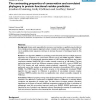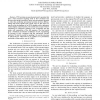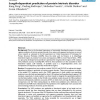145 search results - page 11 / 29 » Predicting DNA-binding sites of proteins from amino acid seq... |
BMCBI
2008
13 years 7 months ago
2008
Background: Amino acids responsible for structure, core function or specificity may be inferred from multiple protein sequence alignments where a limited set of residue types are ...
BMCBI
2007
13 years 7 months ago
2007
Background: Thermophilic organisms are able to live at high temperatures ranging from 50 to > 100°C. Their proteins must be sufficiently stable to function under these extreme...
CIBCB
2005
IEEE
14 years 1 months ago
2005
IEEE
— PTS1 proteins are peroxisomal matrix proteins that have a well conserved targeting motif at the C-terminal end. However, this motif is present in many non peroxisomal proteins ...
BMCBI
2006
13 years 7 months ago
2006
Background: Due to the functional importance of intrinsically disordered proteins or protein regions, prediction of intrinsic protein disorder from amino acid sequence has become ...
NAR
2006
13 years 7 months ago
2006
ACT dbPTM is a database that compiles information on protein post-translational modifications (PTMs), such as the catalytic sites, solvent accessibility of amino acid residues, pro...



